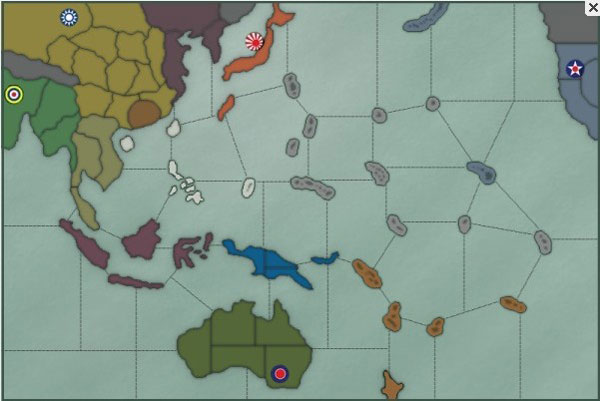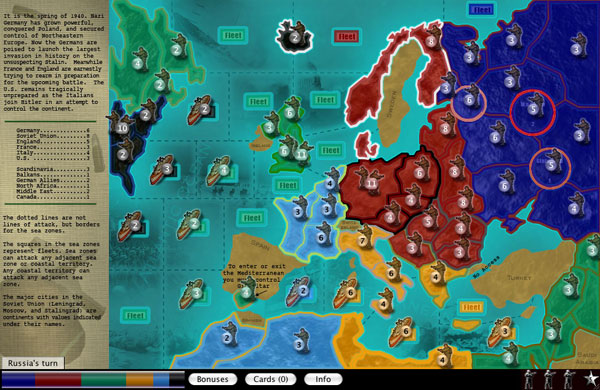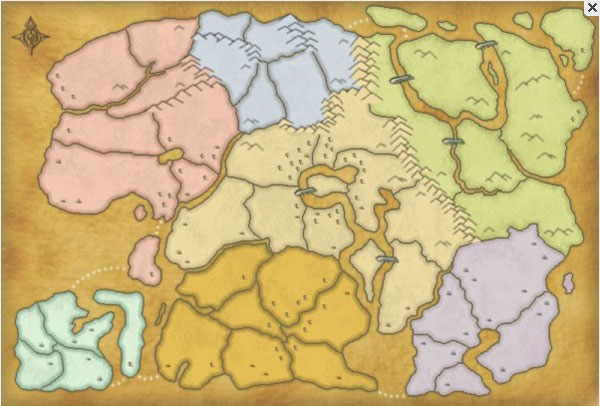Risk has expanded greatly in recent years. Risk began its life in the 1950s and the fact that it is still widely available and popular is a testimony to its success. In its relative long history, as far a modern board games goes, Risk rules have been updated countless times and many varieties have been created and use especially when Risk has been introduced in different countries.
As computer technology progressed, official Risk games started to appear on computer games and these in turn introduced a variety of new options and maps that people could use. However, it wasn’t until the advent of unofficial Risk games that Risk and its endless amusing varieties took off. Many Risk game providers simply started their life by introducing classic Risk and an ability for players to play on different maps. Later, they made it easier for players to make maps and suddenly a whole variety of fan made maps from Star Wars, to Lord of the Rings to some elegantly topologies appeared on these sites.
Players liked these new trends so much that they simply started to ask a new question; “if we can change the maps, can we change other rules?” Today, many of competing unofficial Risk games differentiate themselves from one another by the variations they provide as well as the potential options available. Good options get replicated and certain varieties prevail or become the new standard.
This article systematically examines Risk variations and explores all areas were variations have been introduced. This will help those eager players who are constantly in search of making something new to get inspired by these custom Risk games and get more mileage out of their games.
Potential varieties can be classified into a number of areas. The following lists these areas along with a number of common examples. The idea is to outline a structure to see what areas can be changed. Remember, at the end of the day, we still want to play Risk and so there is only so much we can change before the game becomes something else.
Maps
Risk was originally played on an abstract map of earth with 42 territories. The map can be changed to anything as long as the following are defined:
- Territories and their topology (how they are connected)
- Continents and which territories belong to them
- Bonus value of each continent
Examples
- Lord of the Rings Map
- Moon map of Risk 2210AD



Overall Goal
The classic goal in Risk was to conquer the whole world. Of course you can have many other goals which may not be common to all players.
Examples:
- Mission card. A card contains a mission, such as “conquer player Red and Blue”, or, “Conquer Africa and Europe” and you must be the first to achieve your mission to become the winner.
- Capitals. Every player has a capital. To win, you must conquer all other capitals while holding your own.
- Point game. You receive points for eliminating other players in the game. Hence, the longer you last in the game the more points you receive. Points are calculated across many games and a ranking table is compiled to show which player has earned the highest number of points.
- Assassination. Each player is assigned a target. As soon as that target is eliminated from the game, the player who was assigned that target wins.
Game Rules
In the classic game, armies are used throughout the game to gain territories. Certain rules are used to make sure the game is not open to exploitation while making it fun and entertaining. Change of game rules can fundamentally change the game play and any variation must be thoroughly tested to make sure all “exploitation holes” are covered.
Examples
- Capping.
- Total possible armies in each territory are capped.
- Total armies that can move from one territory to another are capped.
- Attacks.
- Each territory can attack only one other territory (as opposed to the classic rule where you can attack as many as you like)
- Attack and defence rules of engagement can be modified in many ways.
- Diplomacy. Alliances are banned.
- Leader token. A special token is used as a leader. When a leader is present in a territory, it can have an effect on the outcome of any battle from that territory.
- Set leaders. Every player has a leader from the start.
- Buy leaders. You can buy leaders for X number of armies.
- Exchange leaders. You can exchange leader tokens as part of your ongoing negotiations. You may even trade them for armies or cards.
- Team play. Teams play against each other. When a team wins, points are assigned to each player which contributes to their overall points.
- Attrition. A territory will lose a number of armies each turn.
- Retreat. An attacked army can choose to escape to neighbouring friendly territories rather than getting annihilated. In other words, this is a strategic retreat which is a common technique used in the real world. Before an attacker throws his dice, the defender can choose to flee to a connected territory or stay put and defend by throwing his own defence dice.
- Nukes. Players have nukes and when another territory gets nuked, its armies are totally annihilated and the territory becomes a wasteland. In effect the armies are replaced with the same amount of army from a neutral player colour. Neutral player does not engage others, but defence dice are used when attacked by others.
- Extra cards. A set of random cards depicting natural disasters are introduced. When a player draws one, the subsequent territory is rendered wasteland and is treated much like the wasteland caused by nukes described above.
- Fog of war. You can only view enemy positions next to your neighbours. This is common in online games.
- Strongholds. Each player can assign a territory (or territories) as stronghold by placing an especial token on them. When attacked you get bonuses on your dice calculations. For example, you can add 1 to your defence dice roles when attacked on these territories which make it difficult for the attacker to win.
- Arms trade. Any player can provide armies to another in exchange for any territory on the map. In other words you can obtain a territory through peaceful means even when you are not a neighbour of it. The number of times this can take place can be capped to control the game flow.
Initial Placement
At the beginning of the game, armies can be placed on the map in different ways.
Examples
- Random placement. Territories are populated randomly with all players’ armies.
- One army. In this variation, one army is placed in all countries randomly. Next, player can top up their assigned territories one at a time until a total has been reached.
- Three armies. Three armies are placed in each territory randomly for each player, irrespective of the number of players or the number of territories on the map. This is common in most online Risk games.
- Selective. Each player can choose one territory at a time and place one army on them. After all territories are claimed, players continue to top up their territories until a total has been reached.
- Total possible armies. Total number of armies received at the beginning of the game for each player can be varied.
Dice
The classic dice rules rely on using three red standard dice for attack and two standard white dice for defence. A variety of dice rules have been proposed with various effects. New dice rules are usually introduced in conjunction with new game rules.
Examples:
- No dice. Elimination of random battles altogether by removing the dice. When a territory attacks another, their armies are simply subtracted from each other and the remaining is used to distribute between the two territories.
- Number of dice. Variation on the number of dice used.
- Number of armies. Variation on the number of armies lost when dice are thrown.
- Capitals. Especial dice rules are used when attacks take place from a special territory such as a capital.
- Leader. Especial dice rules are used when attacks take place from a special territory that contains a special token such as a leader.
- Non-standard dice. Use of dice with more than six sides each.
Fortification Rules
Armies can move on the map in many different ways in the fortification move at the end of each turn resulting in different tactical game play and a significant change on the length of games.
- Single adjacent. At the end of your turn you can move as many armies as you want from one territory to another territory as long as they are neighbours.
- Multiple adjacent. At the end of your turn you can move as many armies as you want from many territories to other territories as long as they are neighbours.
- Connected. At the end of your turn you can move as many armies as you want from one territory to another territory as long as they are connected with a series of your territories.
- Unlimited. At the end of your turn you can move as many armies as you want from as many territories to any other territory as long as they are connected with a series of your territories. This variation is by far the most tactical as it lets you think of many manoeuvres.
Cards
Cards are collected during the game. The usual rule is to receive one card each turn if you manage to capture at least one territory. You can then cash these cards later in the game based on different formulas.
- No cards. No cards are used in the game hoping to eliminate anything random. This can significantly extend the length of the game.
- Constant. Anyone who provides a set of cards receives a constant amount. This amount is set at the beginning of the game. 4 or 6 are common values. This variation can extend the length of the game significantly.
- Flat rate. Different bonuses are used for different card combinations. For example, you will get 4 for three red cards, 6 for green cards, and 8 for blue cards and 10 for mixed cards. This is common terminology in online Risk games. Of course, you can replace red, blue and green with horse, cannon and soldier. This variation introduces randomness in the game that some players may not like.
- Sequential (also known as escalating). Cards are cashed based on a sequence. For example, the first player who can provide a set of cards gets 4, the next gets 6, the next gets 8 and so on. These are usually recorded as 4,6,8,... The choice of the numbers has a direct effect on the length of the game as well as end game randomness. You need to choose wisely. Other examples are:
- 4,6,8,10,15,20,...
- 4,5,6,7,...
- 4,5,6,8,10,12,14,...
- Random. A set of cards can be cashed for a random number of armies between two set limits. This variation is usually implemented in computers though it can be implemented manually as well using dice.
- Bonuses based on cards. When you cash in, you get certain number of armies for any territory you own. A classic rule is to place 2 armies in each territory you own. Many variation of this rule exist. For example:
- Bonus for every turn. You get bonuses for every card you hold every turn (not only those that you cash in). This encourages holding on to a territory as a powerbase simulating generation of hardcore supporters.
- Paratrooping. You can place the bonus armies in any territory you hold.
Continents
In classic risk, owning a continent is an important part of the strategy as they can provide handsome bonuses each turn. The following variations are common.
Examples
- Biased continents. New maps require new bonus calculations based on continents. The classic Risk map is well balanced. In other words, you receive more bonuses as it gets more difficult to get a continent. Some maps can be designed to provide huge bonuses for an easy to conquer continent which encourages competition between players for these hotly contested parts of the map.
- Bonus inflation. As the game progresses, a percentage is added to each continent bonus. For example, continent bonuses are increased by 20% each round. This increases the value of continents in comparison with cards especially towards the end of the game reducing the randomness created by cashing cards. This variation is more common in online games because it is easier for a computer to keep track of the bonus calculations.
Sequence
In the classic Risk game, players take turns one after the other to finish the game. With the advent of online Risk computer games, it became necessary to adjust the rules so that games could be played by people from anywhere on the planet round the clock. The following variations exist.
- Sequential. Each player must complete his turn before another player can play. Turn time is used as a variation. Turn time limitation is a necessity in just about any online Risk game. Turn time examples are:
- 24 hours, 16 hours, etc.
- 10 minutes or so in classic board games, though this limit is not usually imposed.
- 5 minutes, 3 minutes, 1 minute, etc. encourages fast Risk games with really short turn time. Although the game is turn based, the incredible short turn time makes it feel like a real-time strategy game.
- Simultaneous. A common variation in online Risk games is to let players play simultaneously. In each round, players can login and make their moves. Notice that they may not necessarily play at the same time, only that the next round is open and will be finished at a set time.
- Long turn time. The turn time is long such as 24 hours. All players must make their move before expiry or miss their chance. This means, it is possible that player may end up playing at the same time.
- Short turn time. If turn times are reduced to minutes, the game is effectively converted to a real-time strategy game where you must think quickly to make your moves while others do the same.
This covers the most important areas of Risk and representative variations. If you can think of other novel variations that are tested and popular, perhaps in your local part of the world, please comment and let everyone know what they are. If you want to discuss the details of your ideas on variations and iron out the rules or perhaps get ideas from others, please use the forums. You can then post a comment describing the gist of the variation here.
I will compile your variations and update this article as we go on so we can have a complete list of variations for Risk fans to use.
Enjoy the game.